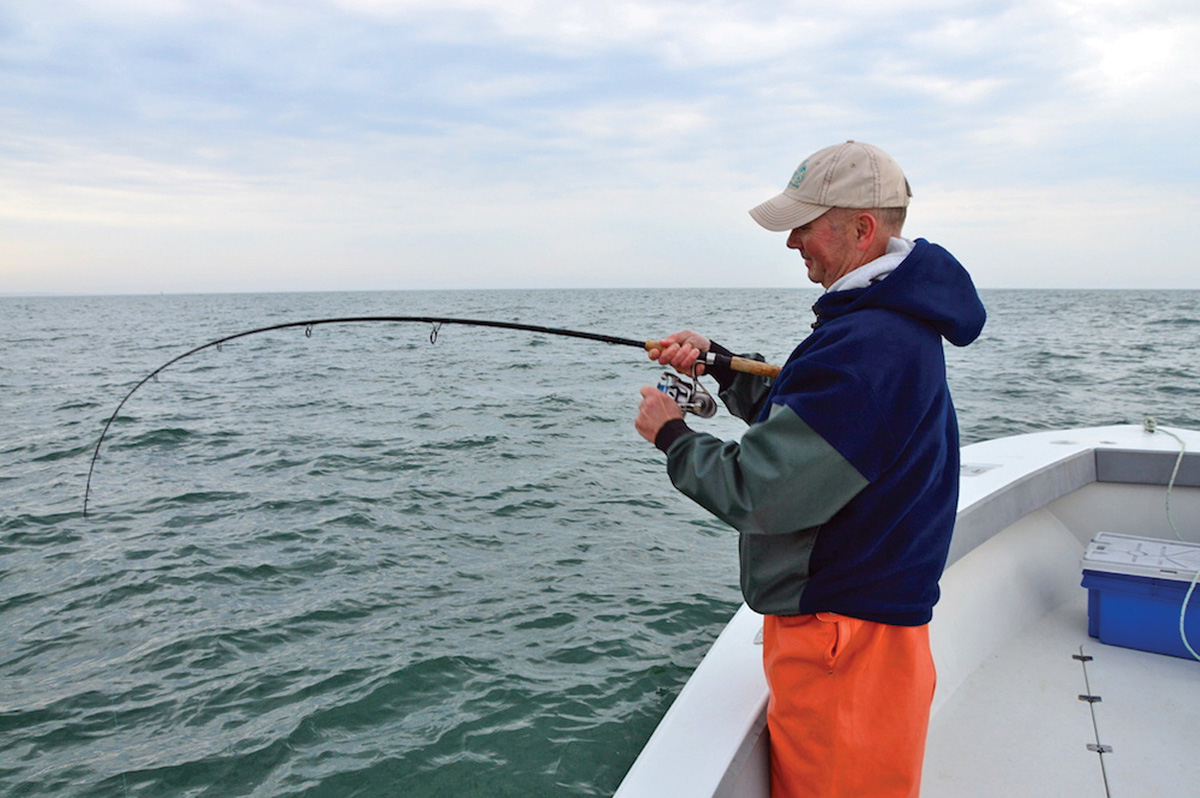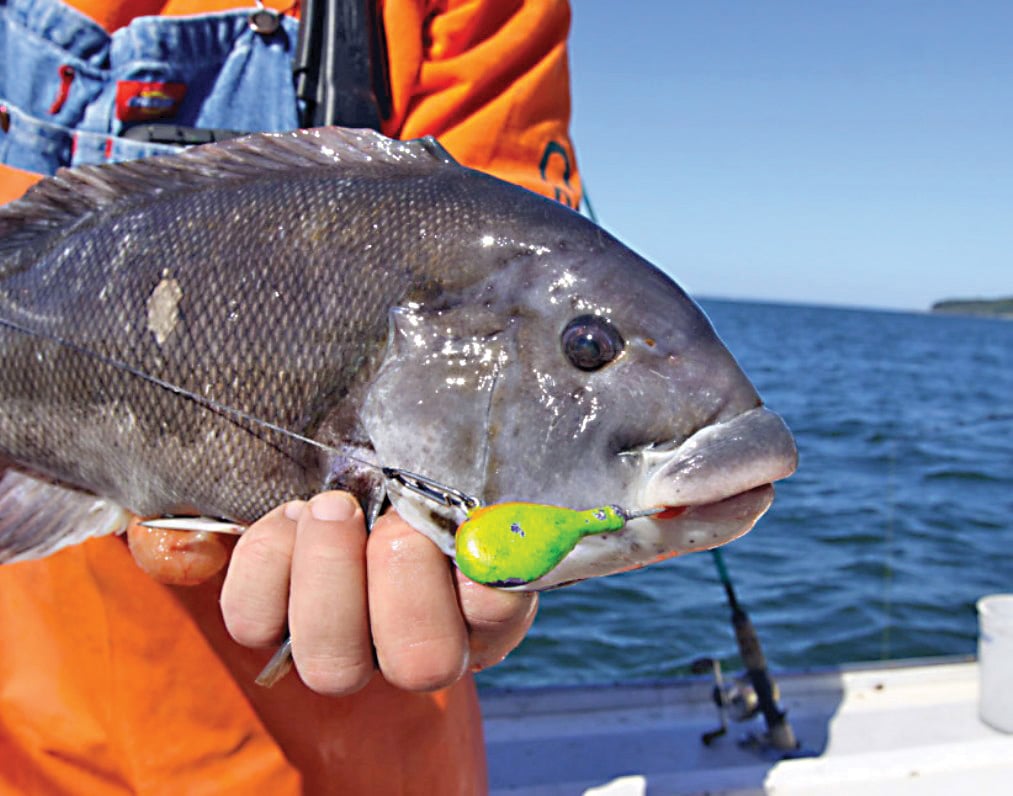
November is prime time to tackle tog in the shallow reaches of Long Island Sound.
As a bottom fisherman, the anticipation builds, and my heart misses a few beats as November approaches. For me and my buddies, the eleventh month means it’s time to hit the launch ramps and scour the rocky peninsulas and points that line our Island’s North Shore for our fall favorite, the blackfish. Adding to the appeal is the ability to fish productive structure with jigs rather than standard bottom rigs, easy anchoring over fertile bottom, and being able to battle tog on the lighter tackle used to serve up jig and crab combos. November is the month that anyone with a reliable small craft, some spinning gear, a handful of jigs and a supply of crabs can have a blast drilling out chunky blackfish from relatively shallow rock piles.
Near Shore Structure
One of the biggest advantages of targeting North Shore blackfish is that there are numerous near shore locations that are easy to access and, depending on wind direction, can be relatively sheltered. Whether a novice or a pro, most of the rocky points that jut from the shorelines bordering Little Neck Bay, east to Orient Point, will produce for you during late October, into November. As September fades to October and Sound waters begin to cool, blackfish begin their inshore migration to shallower, structure rich waters. During the early part of October, blackfish will more than likely have to share their rocky lairs with sand porgies and pin sea bass until water temps drop to the magical number of 55 degrees at which time most of the baby scup and biscuits will head off to deeper, warmer water to join their older siblings. Back along the rocky shoreline, tog will hold down the fort until water temperatures plummet below 50 degrees at which time they too move off to deeper, warmer water nearer to their 55-degree comfort zone. When temperatures drop below 50 degrees, which on the Sound usually occurs around mid-December, the tog develop a pale, whitish color tone and go into a semi dormant state in depths up to 150 feet for the winter.
While some rock piles are limited to groins or shields to prevent beach erosion, just about every point has a spillover of boulders reaching out into the Sound. Most of this structure rests in depths ranging from 20 to 50 feet, which is perfect for targeting tog during October and November. While the west end of the Sound sees a good influx of keeper tog by mid-October, the bite spreads east where it peaks during November. Most shoreline structure will have a healthy mix of tog ranging from shorts to 6 pounds, however whitechins hitting the double digit mark are always a possibility. Areas like Crane’s Neck and Old Field Point generally give up fish from shorts to 4 pounds, while areas such as Truman Beach, Mulford Point and Rocky Point tend to produce more keepers in the 3- to 5-pound range. Forget those monster togs of yesteryear. Unless you have a wreck that pretty much belongs to you, the accuracy of today’s electronics, and especially the harvesting of blackfish in pots, have done a fine job of dwindling the population of big whitechins.
Jigs Over Rigs
It seems that the days of hook, line and sinker are things of the past for many savvy blackfish sharpies who have transitioned to lighter tackle and specially designed blackfish jigs, an approach that many others have also turned to in recent years. While jigging for blackfish is nothing new, the tackle and jigs themselves continue to evolve, and the advantages of “jigging” for blackfish are too numerous and hard to ignore. The bean-shaped design of most tog jigs slices through the water column enabling anglers to significantly downsize their payloads from the typical 3 to 4 ounces of lead to a 1-ounce jig. Unlike a multi-lined, multi-hooked and weighted bait rig, you can use the jig to prod every nook and crevice where a tog might be hiding. And contrary to what most tog angler’s fear, hang ups are far less frequent than with your typical hook and sinker rig. The compact nature of the jig and the fact that the hook rides up are the main reasons why the jig remains out of harm’s way during much of its time on the bottom. Inevitably, the jig makes the angler more involved rather than sitting around waiting for a tog to come along. In fact, a crew that works together will often move along the deck, walking the jig along the bottom and prodding every likely blackfish den from every possible vantage point, covering every inch of a potential honey hole.
Getting Crabby
It’s paramount to understand that the jig on its own is not what entices the tog; it’s the crab hooked to the jig that causes all the ruckus. The dappled color scheme of green and orange was designed to make the jig blend in among the filtered light and varied bottom where blackfish thrive. Although blackfish will crunch up all manner of crabs including rock crabs, green crabs and hermit crabs, Asian crabs are on the A-List in rocky terrain. Using them whole by running the hook right through the middle of their bodies is the ticket.
Understand that in recent years Asian crabs have plagued the rocky shorelines along much of the Northeast Coast. For those with the time and ambition to acquire their own, gathering a day’s supply is as simple as visiting a rocky strewn shoreline along the North Shore during low tide, turning over some stones and snatching up the Asians as they try to scat away. If you plan on fishing the crabs in a day or two, you can keep them healthy in a container in the fridge. Otherwise a few days out of the water will have them perishing, which will cause your spouse to throw you and the awful smelling crabs out. The best case scenario is keeping a live baitwell at boat side. Then you can keep the crabs lively for as long as you please. Asian crabs will most often succeed when all other baits fail. Green crabs are the easiest to obtain from tackle shops and will draw plenty of attention from blackfish. Stone crabs (aka white crabs) are a natural enemy to the tog and a top notch bait later in the season when the water becomes cool, and the tog relocate in deep water.

Keep It Light
Spinning rods in the 7-foot range with enough backbone to coax a big tog away from structure yet light enough to effectively “feel” a 1-ounce jig, matched to a reel loaded with 20-pound braid and a top shot of 15- to 20-pound fluorocarbon is the way to go. Choosing fluorocarbon over a nylon or mono leader is imperative in water less than 30 feet deep. Some anglers may disagree, however some of my good buddies who rate sharpie status when it comes to togging, swear by the lightest fluorocarbon you can get away with. They attribute their better numbers and bigger fish to the fluorocarbon.
Next comes the difficult task of mastering the feel of the nibble. There are times when the chew is fast and furious, and the blackfish are hitting like jackhammers with instant hook ups as they inhale the crabs, making it look easy. The more typical scenario however is for the fish to nibble at the crab. Depending on your dexterity, your swings will result in far more strikeouts than base hits. Ignore those small nibbles as most likely those rapid fire, soft hits are small bergalls (cunner), pin porgies and pin sea bass. You will have to contend with the little guys when using cut crabs or clam baits, whereas with whole Asian or small, whole green crabs the juveniles are more easily discouraged, upping your chances at a keeper tog. Once you feel something a bit different, raise the rod tip slightly, and as soon as you feel the second take, raise your rod firmly and set the hook.

Anchors Away
Some basic knowledge and your GPS can put you pretty much where you want to be. Anchoring for blackfish is almost always imperative, especially among rocks and running currents, although more and more anglers are discovering the virtues of an electric motor linked to their GPS to hold position over a piece of structure. If you are anchoring, you will need an ample supply of line to hold and move around over structure. Keep in mind that the productive depth may vary, so make sure you have enough anchor line to handle depths from 20 to 50 feet. Since there is always the possibility of the anchor getting wedged in between rocks, you should always have a backup plan with at least another anchor, chain and rope. Speaking of chain, make sure you have at least 12 feet of solid galvanized chain that is suited for the size anchor you employ. Remember, the longer the chain the quicker it will set, giving better control when setting up over a preferred spot. When it becomes time to lift the anchor, you’ll want to resort to an anchor ball, which makes life a lot easier. This is especially true when the current builds, and it’s time to make a move or head back to the ramp or dock.
Lastly, keep in mind that the Sound can whip up quickly due to a change in wind direction or a fast approaching weather front. Winds from a southerly quarter put you in the lee along the Long Island shoreline, but light winds from the north and west are also ideal. Avoid any forecast that calls for stiff winds out of the east, west or a northerly quarter. Make sure your VHF is in good working order and the PFDs are within easy reach of everyone on board. As always, please practice self-restraint and please stay within the limits of the law.
| LONG ISLAND SOUND HOT SPOTS |
|---|
| Execution Rocks: 40 878 300/73 738 400 Centre Island Reef: 40 55 003/73 31 037 Matinecock Reef: 40 54 579/73 37 741 Smithtown Reef: 40 55 975/73 11 170 Stratford Shoals: 41 060 000/73 101 600 Orient Point Light: 41 163 400/72 223 400 Little Gull Light: 41 206 110/72 106 700 Old Field Point: 40 9770/73 1186 Cranes Neck: 40 9618/73 1473 |




